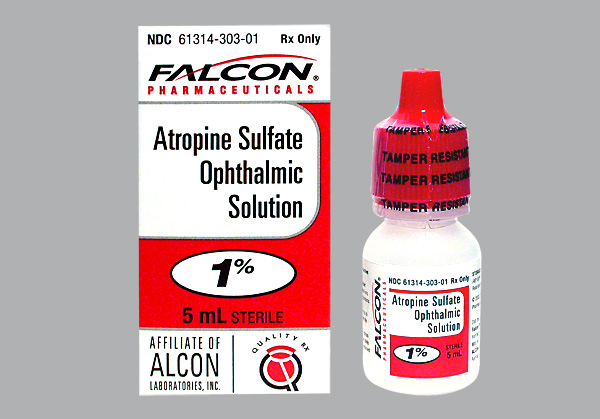Atropine is a poisonous compound found in the deadly belladonna plant. Atropine is used as a muscle relaxant that inhibits nerve responses and for dilating the pupil of the eye. It can be administered either through eye drops, injection, or in oral form. The atropine mechanism of action is classified as an antiparasympathetic(parasympatholytic), or anticholinergic drug. However, it's more accurately an anti-muscarinic agent, because it counteracts themuscarine-like behaviourof acetylcholine and other choline esters.
What's Atropine Used For?

Atropine reduces excretion in the mouth, respiratory passages, relieves spasms and the constriction of the respiratory passages. Atropine can also diminish the paralysis of respiration resulting from the actions of toxic agents on the central nervous system prior to surgery. Atropine-induced parasympathetic is especially useful on the heart, where tachycardia develops due to paralysis of vagal control. Small doses of atropine slow down the heart rate before characteristic tachycardia develops. It is also used to treat spasms in the intestines, stomach, and other organs. It can also be used as an anticholinergicby blocking the effects of acetylcholinein the stomach, intestines, nervous system, urinary tract, certain glands, and other tissues.
Atropine Mechanism of Action
1. Cardiovascular Action
- Cardiac action: The atropine results in modifications of the heart rate. In low doses, a slight slowing of the heart is attributed to the incidental parasympathetic effect and central vagal stimulation that leads to a short term increase of acetylcholine. A more moderate dose generally results in heart acceleration by the elimination of reflex bradycardia, and the reduction of vagal tone amid arterial hypertension.
- Action on the arterial pressure: Atropine in a therapeutic dose does not cause changes of arterial pressure even though the heart rate increases, and does not have any vascular effects. However, a very high or toxic dose will cause a fall of the arterial pressure by depression of the cutaneous vasodilation and vasomotor centers that may be secondary to a histamine release.
2. Eye Action
- Atropine eye-drops results in passive mydriasis or pupil dilation, and increases the diameter of the iris by stymieing parasympathetic influence on the eye.
- In treating people predisposed to narrow-angle glaucoma with atropine, it tends to elevate intra-ocular pressure that hinders evacuation of aqueous humor (clear fluid filling the space in the front of the eyeball between the lens and the cornea), by the Schlemm channel, and should not be used in these patients.
- Atropine can cause paralysis of the ciliary muscle or cycloplegia, resulting in disturbed vision.
- The atropine mechanism of action can last very long, and dilation of the pupil can persist over several days.
3. Action on Smooth Muscles
- With the exception of vascular muscles, acetylcholine contracts smooth muscles, and atropine has an antispasmodic response by inhibiting this acetylcholine effect.
- Atropine also acts in the digestive tract by decreasing amplitude, tone, and frequency of contractions. It works well in conjunction with morphine, because it decreases hypertonicity created by the morphine when treating for colon pain.
- The antispasmodic qualities are also exerted on bronchi, biliary tract, urinary routes and bladder. The bladder also receives parasympathetic and sympathetic innervation, and the sympathetic nerve dilates the bladder constricting its internal sphincter. However, the parasympathetic constricts the bladder and relaxes the internal sphincter, which can induce urinary retention, especially in case of prostate hypertrophy.
4. Action on Secretions
- Digestive system: The atropine mechanism of action on the digestive system inhibits salivation and results in a dry mouth, significantly reduces gastric acid production, and accelerates the healing of gastric ulcers.
- Bronchia: The effect of atropine reduces sputum or mucus production in patients with asthma, and chronic bronchitis.
- Skin: Atropine can be used to control sudation, or the action process of sweating. However, caution must be taken into consideration on a hot day, because inhibiting the sweating process could lead to hyperthermia.
- Eyes: Atropine helps control excessive lacrimation, or the secretion of tears, which often serves to lubricate and clean the eyes in response to an irritation.
Possible Side Effects of Atropine
- The majority of the side effects of atropine are directly related to its anti-muscarinic properties. However, they could also include blurred vision, dry mouth, photo-phobia and tachycardia that commonly occur with the chronic administration of moderate doses.
- Another side effect is anhidrosis, or the inability to sweat normally, which can lead to overheating, and sometimes to hyperthermia, a potentially fatal condition.
- Difficulty in micturition and constipation may occur in elderly patients. Other side effects include dilated pupils, palpitation, hot dry skin, difficulty in swallowing, thirst, restlessness, dizziness, tremor, ataxia, and fatigue.
- Toxic doses can lead to marked restlessness, excitement, delirium, hallucinations, and coma. Severe intoxication could result in circulatory collapse where the blood pressure declines that is followed by paralysis, coma, and eventually death due to respiratory failure.
